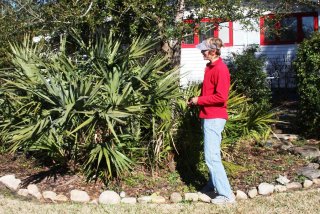|
Article Courtesy of The Florida Times Union By Maggie Fitzroy Published January 31, 2010 Even in the dead of winter, Linda Dunne's yard stands out. Tall cactuses frame the front yard of her Sawgrass Country Club home, and the grounds are not covered with St. Augustine grass, like her neighbors', but with jasmine and dwarf chenille ground cover. Holly trees flourish next to white lantana. Rocks outline flower beds that feature holly ferns, ginger and Bird of Paradise. Dunne, a St. Johns County master gardener, said she designed her yard to feature Florida native and Florida-friendly plants because they don't need fertilizers, watering or much maintenance. Even in the midst of summer, "we can be gone for a month and don't have to do anything," she said.
St. Johns County horticultural agent Keith Fuller said the law encourages the nine basic principles of Florida-friendly landscaping, which are: use the right plant in the right place, water efficiently, fertilize appropriately, mulch, attract wildlife, manage yard pests responsibly, recycle, reduce storm water runoff and protect the waterfront. One of the bill's key provisions states that any landscape that follows Florida Yards and Neighborhood Guidelines promoting the nine principles supersedes and takes precedence over all other municipal, county and homeowner association rules, ordinances or laws, because "the use of Florida-friendly landscaping and other water use and pollution prevention measures to conserve or protect the state's water resources serves a compelling public interest." As a certified gardening expert, Dunne is well aware of the bill that promotes the type of gardening she has been practicing for years. She hopes that as other Beaches residents learn about it, no matter what type of neighborhood they live in, they too will begin to practice its principles. "Can you imagine the sensual pleasure of living in a neighborhood where you don't have lawn mowers, blowers, weed eaters and the smell of chemicals?" she asked. "You and your children and pets would live in a relatively chemical-free environment, and all of this would hopefully also save our water." Dunne began removing the St. Augustine grass from her front yard in 1998, replacing it with attractive and colorful Florida-friendly plants. Since she removed patches of grass gradually, she didn't run into any opposition from the gated community's homeowner association and she didn't need the new law to protect her. However, a homeowner in the L'Atrium community in Ponte Vedra Beach who recently ripped up his St. Augustine grass front lawn encountered protests from his community association, said St. Johns County horticulture agent Joe Sewards. The homeowner replaced the grass with Florida-friendly trees, shrubs and other plants, then covered the remaining soil with mulch. After neighbors complained, the homeowner association cited the resident and called for a hearing. With the new state law on his side, the resident won the right to keep his new Florida-friendly yard intact. But Seward said people need to be careful if they decide to change their yards, because they could encounter problems if they don't stay within the general landscape theme of their community. "It depends on the situation," he said. Right plant, right place means there are a number of alternatives to St. Augustine grass, including a variety of grasses or ground covers. Seward said the Senate bill's intent "is to encourage Florida-friendly landscaping principles; it does not mandate them." People shouldn't "go out and rip out their landscapes," without a plan that's preferably sanctioned by their community, he said. Some native plants might not be appropriate "because home landscapes bear little resemblance to native landscapes in many cases." Some homeowner associations are concerned that people are just going to rip up their yards, Fuller said. "But they will have to work it out in some fashion, because a lot of people in gated communities don't like all the grass they have to have." Later in the year, county horticulture agents, who work through the University of Florida Institute of Food and Agricultural Sciences, plan to schedule information meetings for homeowner association representatives, Fuller said. He recently received a call from a man in St. Augustine Beach who radically changed his yard, so much that it doesn't flow with the rest of the community. That is causing him problems with his neighbors. Fuller suggested that people who want less lawn keep some grass pads. To educate people about Florida-friendly landscaping, he plans to schedule classes in March at the Ponte Vedra Beach branch library. For some Beaches gardeners who are longtime fans of Florida native plants, the new law is welcome news, even if they don't need it to protect them from community restrictions. Laurie Clarke of Neptune Beach keeps a "pesticide free" sign in her front yard on South Street. She has so little grass that she can use a push mower. The rest of the property is covered with various types of ground cover, trees and flowering shrubs and vines that don't need water or fertilizer. In the summer, they bloom in a variety of colors. "They're used to the natural cycles of rain here," she said. "They don't need chemical spraying because they have natural defenses to the insects that have adapted to in this environment." She buys Florida natives at a Yulee nursery called Reflections of Nature and at Native and Uncommon Plants nursery in Ortega. She said she especially likes Florida native plants because they support and attract wildlife. Birds love the berries on her beautyberry shrubs. Migratory flocks of robins gobble the berries that grow on her cabbage palms, the state tree. Bees love the dune sunflowers that cover the ground in the place of grass. Hummingbirds and butterflies flock to the orange and red tubular flowers on her firebush shrub. And her saw palmettos, which naturally flourish around the state, make a great habitat for tree frogs, Clarke said. "That's a Florida thing to me," she said. "I look at them and think of Florida." |
